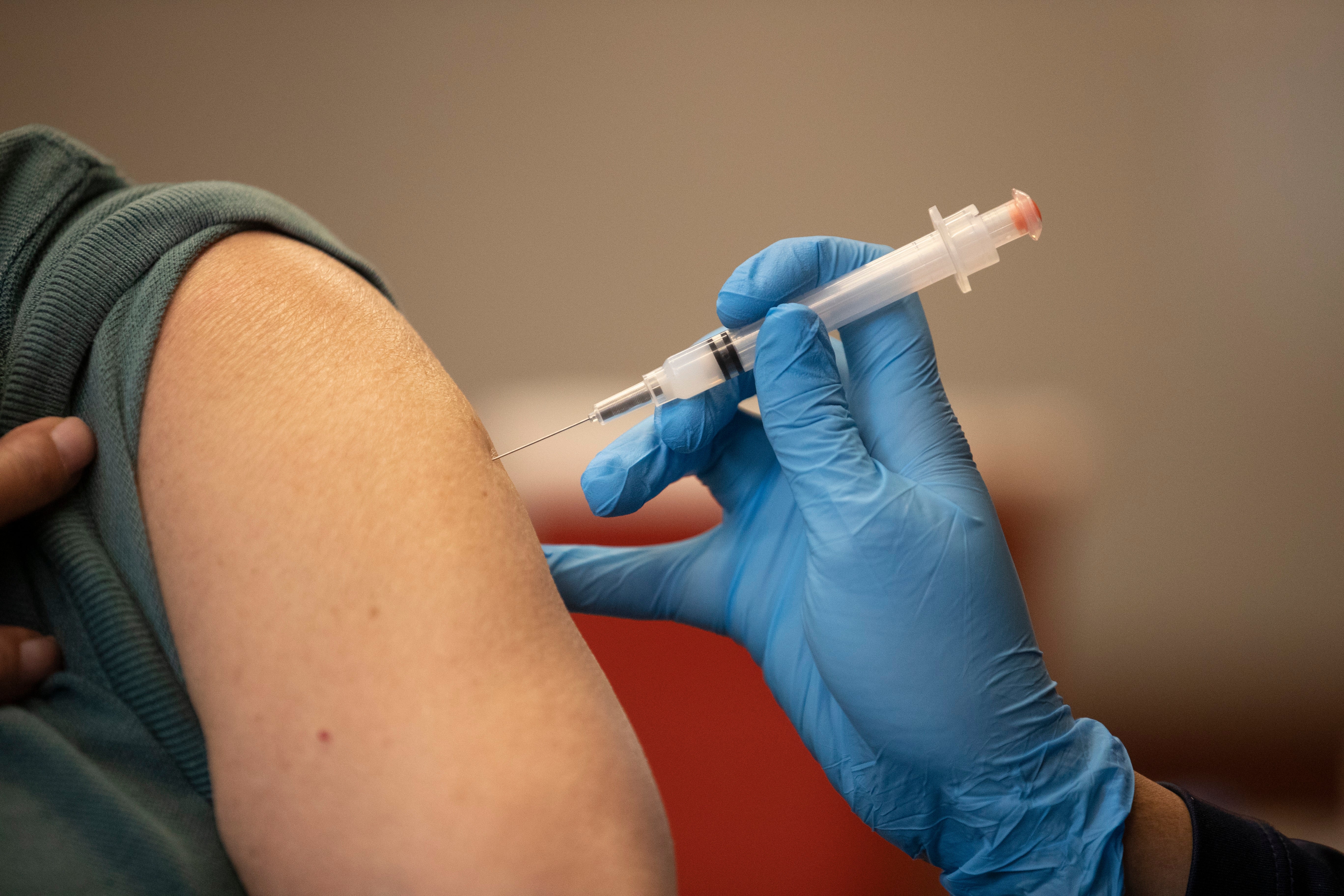yo? let’s fucking go?
the text of the article:
Scientists at UC Riverside have demonstrated a new, RNA-based vaccine strategy that is effective against any strain of a virus and can be used safely even by babies or the immunocompromised.
Every year, researchers try to predict the four influenza strains that are most likely to be prevalent during the upcoming flu season. And every year, people line up to get their updated vaccine, hoping the researchers formulated the shot correctly.
The same is true of COVID vaccines, which have been reformulated to target sub-variants of the most prevalent strains circulating in the U.S.
This new strategy would eliminate the need to create all these different shots, because it targets a part of the viral genome that is common to all strains of a virus. The vaccine, how it works, and a demonstration of its efficacy in mice is described in a paper published today in the Proceedings of the National Academy of Sciences.
“What I want to emphasize about this vaccine strategy is that it is broad,” said UCR virologist and paper author Rong Hai. “It is broadly applicable to any number of viruses, broadly effective against any variant of a virus, and safe for a broad spectrum of people. This could be the universal vaccine that we have been looking for.”
Traditionally, vaccines contain either a dead or modified, live version of a virus. The body’s immune system recognizes a protein in the virus and mounts an immune response. This response produces T-cells that attack the virus and stop it from spreading. It also produces “memory” B-cells that train your immune system to protect you from future attacks.
The new vaccine also uses a live, modified version of a virus. However, it does not rely on the vaccinated body having this traditional immune response or immune active proteins — which is the reason it can be used by babies whose immune systems are underdeveloped, or people suffering from a disease that overtaxes their immune system. Instead, this relies on small, silencing RNA molecules.
“A host — a person, a mouse, anyone infected— will produce small interfering RNAs as an immune response to viral infection. These RNAi then knock down the virus,” said Shouwei Ding, distinguished professor of microbiology at UCR, and lead paper author.
The reason viruses successfully cause disease is because they produce proteins that block a host’s RNAi response. “If we make a mutant virus that cannot produce the protein to suppress our RNAi, we can weaken the virus. It can replicate to some level, but then loses the battle to the host RNAi response,” Ding said. “A virus weakened in this way can be used as a vaccine for boosting our RNAi immune system.”
When the researchers tested this strategy with a mouse virus called Nodamura, they did it with mutant mice lacking T and B cells. With one vaccine injection, they found the mice were protected from a lethal dose of the unmodified virus for at least 90 days. Note that some studies show nine mouse days are roughly equivalent to one human year.
There are few vaccines suitable for use in babies younger than six months old. However, even newborn mice produce small RNAi molecules, which is why the vaccine protected them as well. UC Riverside has now been issued a US patent on this RNAi vaccine technology.
In 2013, the same research team published a paper showing that flu infections also induce us to produce RNAi molecules. “That’s why our next step is to use this same concept to generate a flu vaccine, so infants can be protected. If we are successful, they’ll no longer have to depend on their mothers’ antibodies,” Ding said.
Their flu vaccine will also likely be delivered in the form of a spray, as many people have an aversion to needles. “Respiratory infections move through the nose, so a spray might be an easier delivery system,” Hai said.
Additionally, the researchers say there is little chance of a virus mutating to avoid this vaccination strategy. “Viruses may mutate in regions not targeted by traditional vaccines. However, we are targeting their whole genome with thousands of small RNAs. They cannot escape this,” Hai said.
Ultimately, the researchers believe they can ‘cut and paste’ this strategy to make a one-and-done vaccine for any number of viruses.
“There are several well-known human pathogens; dengue, SARS, COVID. They all have similar viral functions,” Ding said. “This should be applicable to these viruses in an easy transfer of knowledge.



I think this is an AI article. The link to the paper is dead, and every other article I can find on this is pretty much the exact same words and also has that dead link, aside from one Forbes article that I think is just based on these AI written ones. Can’t find anything on PNAS’s site, and the alleged authors don’t list anything that recent on any of their profiles. It’s weird though because it’s on the official UCR .edu site.Edit: My partner (a PhD neuroscientist) and I did some more searching, and we’re now leaning towards “There was a mixup with publication dates” and this press release was published earlier than it should’ve been when PNAS hasn’t actually published the paper yet. The researchers are definitely real and do research in this same field, and we found a grant application that would line up with this project. Hopefully in the next day or two the DOI link will populate. If and when it does I’ll try to remember to post the full text here.
Edit 2: False alarm. My bad y’all. DOI link is live. Don’t publish articles about your papers before the paper releases.
I found the UCR email of the person cited in the paper, I emailed him to make sure.
Sweet, let me know if they respond, I really do want this to be true
yeah the fact it’s on an official university domain leans me towards it being genuine. could be a linking error, could be a date of publication error, idk. you are right that the premise seems like a quantum leap in the state of the medicine, which makes it circumspect.
fingers crossed the DOI activates in the next few days
Why AI, specifically? The article was posted to the UCR website, and appears to have been posted by the science comms person there, who is a real person with a history and credentials. The paper might be fake, but what’s the angle for AI being involved in the article? And what would it matter if it were? The existence of the paper in question seems like the more salient issue, I don’t quite understand what AI has to do with it.
AI being the latest boogeyman, sadly for the left too. Unpleasant remaning of all the other times when people failed to understand the issue and blamed tool for the sins of the toolmaker.
Weird and badly written article with fake but real-looking links where multiple other sketchy websites have the same article verbatim makes me think AI. I hope I’m wrong though.
I think you’re projecting. Lots of websites copy press releases. Indeed, the comms person would want others to publish it verbatim, as the purpose of a press release is to get people to republish the info and get the word out.
If the paper is missing, the only info other people have about this is the press release, and a few of them will publish it while the rest will wait to get access to the paper, so you’d see exactly what you’re seeing regardless of AI involvement: low-effort content publishers copying or summarizing this article while better outlets are holding off until they get more info.
I’m just encouraging you not to look for AI ghosts and goblins when simpler explanations will do. Broken links happen, science comms people at universities make mistakes, news websites are lazy and will publish anything they can get their hands on. I’ll bet you that a real person wrote this and published it, and there’s some sort of mixup about the paper on the backend. Either the paper is fake, and the comms person got duped, or the paper is real and there’s an issue accessing it. AI involvement is irrelevant, up or down.
Yeah this was my bad. I’m on such high alert for fake AI articles and this one set off alarm bells for no good reason.
Which links are fake?
Link to the actual paper, this is what pulls up
Nowhere in the article does it give the actual name of the paper, but searching for either of the authors in the article doesn’t pull it up.
I see. That’s an important link all right.
deleted by creator
Is this the patent in the article?
https://scholar.google.com/citations?view_op=view_citation&hl=en&user=UGHi-8IAAAAJ&sortby=pubdate&citation_for_view=UGHi-8IAAAAJ:dshw04ExmUIC